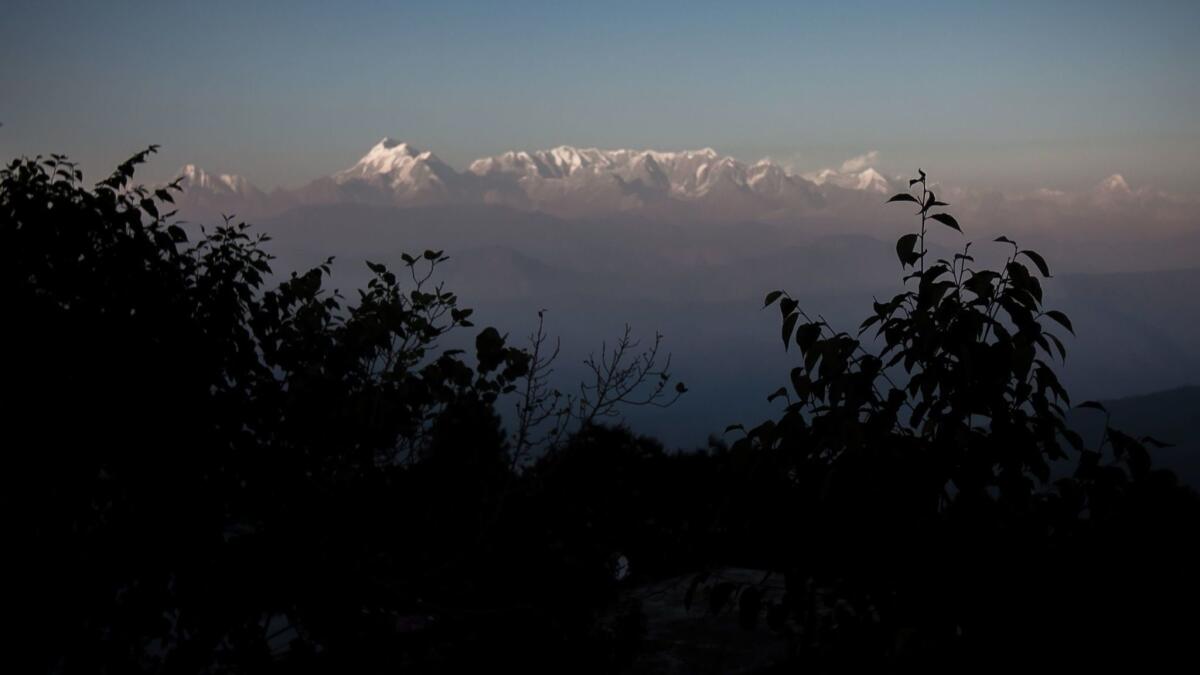Five bodies spotted in search for missing climbers in Himalayas

- Share via
Indian air force pilots spotted five bodies Monday while searching for eight mountaineers reported missing for more than week in the Himalayas after attempting to ascend a twin peak of India’s second-highest mountain.
Officials have not released the names of the missing, but family and friends have confirmed that Ronald Beimel, 34, of Los Angeles, and Dr. Anthony Sudekum, 63, a hand surgeon from O’Fallon, Mo., were among the missing. The mountaineers — including four Britons, an Australian and an Indian liaison officer — were climbing Nanda Devi East, a twin peak of Nanda Devi, the second-highest mountain in India at more than 21,000 feet, when an avalanche struck, officials say.
Vijay Kumar Jogdande, a civil administrator in the northern state of Uttarakhand, said the bodies, which he believes are those of some of the missing climbers, were identified using high-resolution photographs taken from a military helicopter before the rescue operation was suspended for the day because of heavy snowfall and high winds.
The search for any survivors will resume Tuesday, Jogdande said, cautioning that they may have been buried in the avalanche.
Government officials were consulting the Indian army and Indo-Tibetan Border Police on how to retrieve the bodies, which were seen at an altitude of 16,404 feet.
“Both the terrain and the weather make safety a real issue,” Jogdande said. “There is always a fear that people going for the rescue may get stuck there.”
An expedition team of 12 climbers had reached a base camp on May 18, according to the British Mountain Guides. Among the group were British Mountain Guides Martin Moran and Mark Thomas, an Indian liaison officer and support staff.
From there, it’s believed they split into two groups. When the larger group of eight failed to return on time, the other climbers began a search and Thomas found signs that a large avalanche had struck the group’s route, and rescue service staff was alerted.
Weather conditions deterred wider efforts, the guide organization said. The Indian Mountaineering Foundation, which coordinated the search, contacted the authorities and a team of rescuers was dispatched on foot. Harsh weather, however, persisted until Saturday and made it too risky to fly helicopters into the mountains. The weather was too harsh to fly helicopters into the mountains and lasted until Saturday.
On Sunday, Thomas and his team were rescued, but there were no signs of the missing climbers — no tents or any signs of equipment.
“The scale of the avalanche became much more apparent,” the organization said.
In a statement, Moran Mountain, Moran’s Scotland-based company, asked that efforts continue until the status of the missing climbers is confirmed. The company was started by Moran and his wife, Joy, in 1992.
“We are pressing for the search area to be widened and continued,” the company said.
It is unclear why Moran chose an uncharted path. But exploring and establishing new routes are part of mountaineering culture, especially among elite climbers, says Gordon Janow, program director of Alpine Ascents International.
Alpine Ascents International, which offers guided trips, does not lead one up the Nanda Devi or its twin peak because it is a more technical climb, Janow said. The peaks are surrounded by a circle of smaller mountains and harder to reach than Mt. Everest, also in the Himalayas.
Deaths on Mt. Everest have resulted from large crowds and inexperienced climbers, but those issues are irrelevant on Nanda Devi East, Janow said.
“It’s a very brave and arduous undertaking,” he said. “Nanda Devi wouldn’t be something that’s a guided climb like Everest because it’s far more challenging.”
Climbers must be multi-talented to ascend the peak because they could face everything from glaciers, rocks, ice or snow, depending on conditions. This time of year is ideal for climbers because the weather is more stable, but unlike on Everest, the weather patterns are lesser known on Nanda Devi because it is less traveled, he said.
For a while, Nanda Devi was closed by the Indian government because it was considered unclimbable. In total, Janow estimated a little more than a dozen expeditions have been completed on Nanda Devi, which was first scaled in 1936.
Beimel, a Los Angeles-based tour guide and Japanese-to-English translator, has worked for Esprit, a Japanese travel and tour company founded by his father.
Beimel has routinely documented his climbing expeditions on Instagram. His love for the outdoors has taken him to the Scottish highlands and the Cascade volcanoes in British Columbia, Mt. Kaweah in California’s Sequoia National Park and the Northern Lights in Iceland.
“When he is not working he can be found hiking mountain trails, taking photographs, and making music,” his staff biography read. Beimel grew up in a Japanese-American household that instilled in him a lifelong interest in Japanese culture.
In a statement, Sudekum’s family said it is clinging to hope that he is found alive. Family members say they are optimistic, knowing Sudekum is an experienced climber and has training in medical emergency care.
“Our father is a fantastic, passionate, capable individual who was doing what he loved,” the family said.
The Associated Press contributed to this report.
More to Read
Sign up for Essential California
The most important California stories and recommendations in your inbox every morning.
You may occasionally receive promotional content from the Los Angeles Times.















